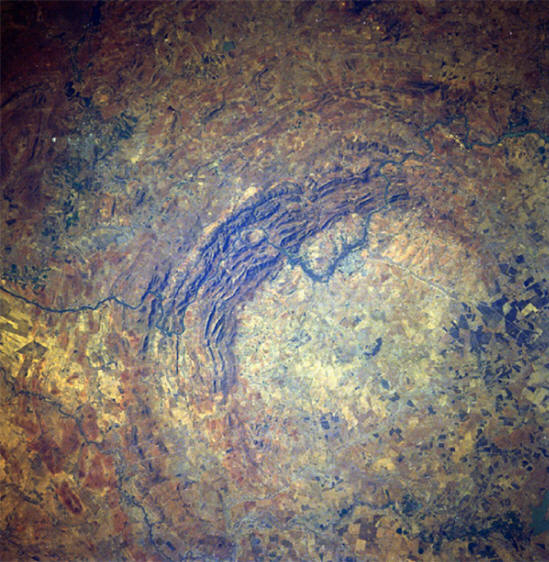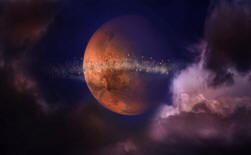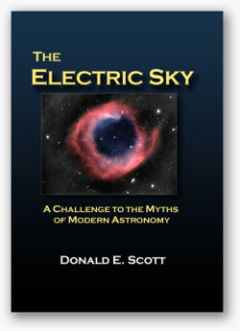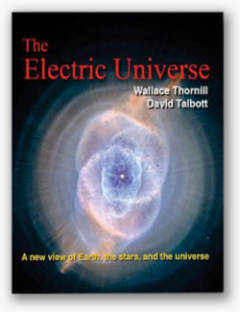|

The multi-ringed Vredefort Dome,
South Africa. Credit: Space shuttle
STS51I-33-56AA.
Vredefort Dome
Nov 04, 2010
The largest crater on Earth
might not have been created by a
meteor impact.
Africa exhibits some of the most
complex terrain on Earth. As has
been suggested in past Picture of
the Day articles, Africa appears to
have been devastated in the recent
past. From the Sahara Desert in the
North to the vast dune fields of
Namibia in the South, African
topography resembles images taken by
spacecraft in orbit around Mars.
There is more to the Martian
connection than sand, however. Mars
is home to some of the largest
craters in the Solar System, while
Africa plays host to the largest
crater on Earth, otherwise known as
Vredefort Dome. The
"dome" is supposed to be a "rebound
peak" where rocks in the crater's
center melted from impact,
consolidated into a single mass, and
then bounced back after the
explosion, freezing into an upraised
mound. A similar process is thought
to have formed the central peaks
that can be seen in many lunar
craters.
Vredefort Dome is located about
100 kilometers southwest of
Johannesburg. It has been classified
by geologists as the oldest and
largest astrobleme on Earth:
approximately 300 kilometers wide,
ten kilometers deep, and nearly two
billion years old. One of the
characteristics shared by Vredefort
and craters on other planets and
moons is that it is a
multi-ringed structure.
Among their common features,
multi-ringed circular formations
possess
flat inner plains with
vertical cliffs, some of which rise
several kilometers. The outer rim of
Vredefort is said to have eroded
away over the eons, explaining why
the crater was identified as a
volcanic dome for decades. The
vertical walls, such as those found
around Popigai Crater in Siberia,
are missing. It is possible that the
rim was scoured away by wind and
rain, but from an Electric Universe
perspective the crater may not have
had a rim from the moment of its
inception.
In the northwestern arc of
Vredefort is a
secondary plain with a
deep outer perimeter, like a
V-shaped canyon, that also resembles
the morphology of other concentric
rings. Surrounding the secondary
plain is
another ring of cliffs
with a gradual drop-off extending
outward from the central uplift.
That pattern is repeated several
times, with shorter cliffs and
broader plains, until they finally
merge into the bedrock.
Was it a gigantic block of stone
that formed Vredefort? Did a
10-kilometer-wide meteor strike
Africa and excavate the giant crater
in an explosion orders of magnitude
greater than that which is supposed
to have killed-off the dinosaurs?
Alternatively, as has been
previously proposed, did
an electric arc of unimaginable
force travel through the region,
vaporizing the terrain and blasting
out a hole along the path of a
sinuous channel known as the Vaal
River?
Some Electric Universe theorists
think that many of the large rivers
and their tributaries around the
world are secondary to whatever it
was that carved the beds in which
they flow. In other words, rivers
have "adopted" paths of least
resistance through the landscape
rather than founding their own
courses. In the case of Vredefort
Dome, the Vaal River cuts through
many tiers of mountains that lie
across its path as if they were not
there.
This anomaly is significant,
since there is no known way for a
river to punch through a wall of
solid rock, leaving a deep canyon.
The river should have naturally gone
around the barrier or gathered into
a lake, not eaten away square
kilometers of the hardest basalt in
a clean cut.
Another anomaly within the crater
is the chaotic magnetic fields that
have been detected in the surface
rocks, reminiscent of the intense
crustal magnetism found in and
around large basins on Mars.
According to Rodger Hart of the
iThemba Laboratory for Accelerator
Based Science in South Africa,
Vredefort's magnetic fields were
imprinted by strong electric
currents flowing in the ionized
gases generated by the energetic
impact.
Mineral deformations,
such as shattercones, requiring
pressures and temperatures far
exceeding anything seen on Earth
today are put forward as evidence
for the impact theory. Indeed,
nonodiamonds are abundant in the
deposits, also conforming to the
consensus opinion. The pressure
waves released by whatever caused
the crater are thought to have
compressed graphite gneiss
formations and instantaneously
transformed them into nanodiamonds.
As Wal Thornhill wrote several
years ago:
"The kinds of things to watch for
are pitting, surface glassification
or a burnt appearance, damage caused
by the explosive release of trapped
gases, shock metamorphism, and
isotopic and elemental
anomalies....One thing to look for
if shocked crystals are found and
their orientation determined, is the
direction from which the blast
originated. Electrical cratering has
a blast center that moves below
ground and around the crater's
center. An impact has a stationary
blast center above ground that
coincides with the crater's center.
An example on Earth of shocked
minerals oriented to a subterranean
moving blast center can be found in
the giant Vredefort Dome structure
in South Africa."
Stephen Smith
Multimedia

“When Meteorites Fell from Mars”
|








